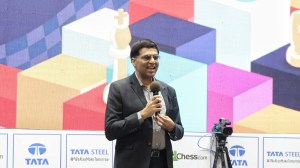Trump’s tariff blow to weigh on India, but will be shortlived: CEA V Anantha Nageswaran
According to him, the order of magnitude could be anywhere between 0.3 per cent and 0.5 per cent this year in terms of real GDP impact.
 Chief Economic Advisor V Anantha Nageswaran at the Express Adda in Mumbai on Wednesday. (Express photo by Narendra Vaskar)
Chief Economic Advisor V Anantha Nageswaran at the Express Adda in Mumbai on Wednesday. (Express photo by Narendra Vaskar)Chief Economic Advisor V Anantha Nageswaran has warned that the additional 25 per cent tariff — taking the total to 50 per cent — imposed by US President Donald Trump on Indian exports will make business conditions extremely challenging and that the ripple effects of this move are expected to be felt in economic growth, particularly in the second and third quarters of the current financial year.
At the same time, Nageswaran expressed confidence that the tariff measure would be shortlived and that there would be “certain recalibration happening from the other side” on it, as the “current approach is not going to be a long-term positive thing in terms of the overall relationship”.
“I do feel that it (high tariff) will be more short-lived than long-lived,” Nageswaran said.
On the other hand, he said the reduction in GST rates announced by the government will boost consumption in the country. “The question is whether it will be of a magnitude that will compensate for the export losses, is a different matter of calculations, but it will definitely offset and compensate for that,” he said at the Express Adda, organised by The Indian Express in Mumbai on Wednesday.
Nageswaran was in conversation with P. Vaidyanathan Iyer, Managing Editor, The Indian Express.
 Express Adda with V Anantha Nageswaran, Chief Economic Advisor to the Government of India, in Mumbai on September 3, 2025. (Express Photo by Sankhadeep Banerjee)
Express Adda with V Anantha Nageswaran, Chief Economic Advisor to the Government of India, in Mumbai on September 3, 2025. (Express Photo by Sankhadeep Banerjee)
“This year, you must understand that in the first four months, up to August, exports have happened without the tariff. So the impact (of the additional 25 per cent tariff) this year will be in the second half of the financial year. Estimates vary about the tariff-exempt and tariff-affected sectors,” he said.
“You can do your calculations, but unfortunately you have to make multiple assumptions about second- and third-round effects on uncertainty, capital formation, and employment. I think there will be an impact on GDP growth in the second and the third quarters, assuming that the situation continues,” Nageswaran said.
According to him, the order of magnitude could be anywhere between 0.3 per cent and 0.5 per cent this year in terms of real GDP impact. The country’s GDP rose to a five-quarter high of 7.8 per cent during the April–June 2025 quarter. The Reserve Bank of India (RBI) has projected real GDP growth for FY26 at 6.5 per cent.
The Chief Economic Advisor, however, said that if the situation remains unchanged, the full impact of the additional 25 per cent tariff will be felt next fiscal. “So the fiscal second and third quarters will be critical, but I hope by then the second 25 per cent (tariff) would have been resolved. If it continues into the next financial year and lasts, that would be a huge challenge both in terms of employment and GDP growth. Difficult to give you precise numbers,” he said.
For India, finding other markets for its exports will not be an easy task, with China – which is also facing challenges with exports to the US and has the ability to finance buyers, offer long lead times for payments, and provide product and price discounts – competing for market share in third markets, he said.
“In that sense, it does raise the dependence on domestic levers of growth that much more. So that is a formidable task on hand for us,” the top economist said.
Higher tariff counterproductive
When asked about reasons for his optimism that the extra 25 per cent tariff would be short-lived, the Chief Economic Advisor said there were signs that the US had realised that a higher tariff on India was probably not yielding the desired results and was becoming counterproductive.
“If you ask me for concrete evidence beyond what I am seeing in the last few days in terms of mixed messaging, I don’t have a concrete basis to give you an answer as to why I think the second 25 per cent will not last long, but it will be more short-lived than long-lived,” Nageswaran said.
Asked about the steps India needs to take to mitigate the impact of higher tariffs, he emphasised that the country has been focusing on things that were good for it rather than responding to tariffs. He said that there has been an increase in India’s purchases of fuel and defence products from the US and overseas direct investment made by Indian businesses in the US over the last 20 years.
He also pointed out that things have been going in the right direction as far as India’s engagement with the US is concerned. “If we continue to do what we are doing, I think there will be certain recalibration happening from the other side in my view because the current approach is not going to be a long-term positive thing in terms of the overall relationship,” the Chief Economic Advisor said.
To a specific question on the steps the government can take to support sectors affected by higher tariffs, Nageswaran said an intervention program could be designed to give them more time in terms of working capital, cash flows, financial payment forbearance, and also emergency credit relief similar to what was announced during the Covid pandemic.
At the same time, Nageswaran said, companies should start thinking of just recovering their marginal cost of production so that they can keep up with production and avoid layoffs. “You (companies) can’t recover full cost, but as long as you are earning a positive contribution, your variable costs are covered. Then the government support should enable you to tide over the phase. As I believe this (higher tariff) is going to be a short-lived phenomenon, I think we should be okay,” he said.
GST cut: Premature to say states will lose out
When asked about states concerns over revenue losses due to GST rate rationalisation, Nageswaran said, “We should also realise that in 2021, if we were in the old system, states would not have had any protection whatsoever with the GST collapse that happened. Had they been in the old system and they were collecting their own sales tax revenues, there would have been no backup for that, whereas the 14 per cent guarantee of GST gave them the cushion.”
“I think it is premature to say the states would lose out because they haven’t lost out so far. We are also not accounting for the possibility that the rate reduction can also spur more economic transactions, which will compensate for the price… It’s like a price versus volume kind of framework. It will be premature to conclude or say that there is a huge risk of revenue loss for states,” Nageswaran said.
There are multiple areas in which states can do more on realising their own tax revenues, he said.



- 01
- 02
- 03
- 04
- 05




























